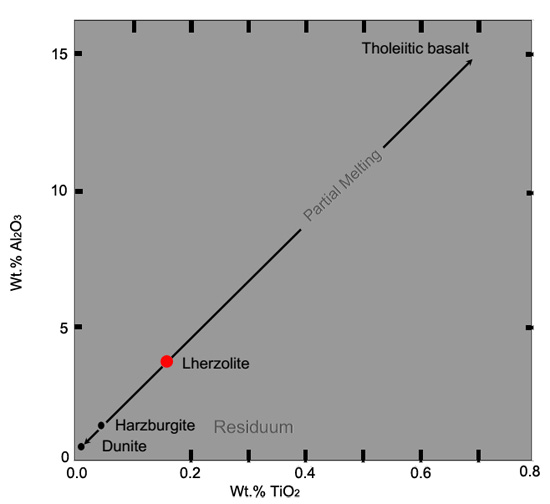Peridotites
Peridotites are a group of ultrabasic igneous rocks containing more than 40 vol% olivine with or without orthopyroxene and clinopyroxene. Accessory phases include garnet, spinel, plagioclase, ilmenite, chromite and magnetite. Peridotites comprise the bulk of the Earth’s upper mantle and are present as xenoliths within a wide range of mantle-derived magmas and within the mantle sequences of ophiolites. The aluminuous phase present in mantle peridotite changes with pressure with plagioclase present at low pressure, spinel at intermediate pressure, and garnet at high pressure. Many mantle peridotites are the residues of partial melting, or have crystallised from partial melts. Peridotites can also form as cumulates in layered intrusions, peridotites from these layered igneous complexes vary widely, reflecting the relative proportions of pyroxenes, chromite, plagioclase, and amphibole. Cumulate peridotites often have cumulate textures and exhibit preferred crystal orientation.Peridotite is the source rock of basalt. Basaltic magma forms when peridotite is partially melted. Melting begins when upwelling mantle intersects the peridotites solidus . With decreasing pressure above the solidus, extent of melting increases. The amount of melting is limited by the heat available since the heat of fusion is large. Extent of melting can vary from ~1% to ~20%. The T, P and % melting determine the composition of the basaltic magma produced.

TiO2 vs Al2O3 diagram for lherzolitic, harzburgitic, ducnitic rocks and tholiitic magmas. Lherzolites (red dot) have an intermediate composition between dunites/harzburgites and tholiitic magmas; through partial melting processes, lherzolites produce tholeiitic magmas and a harzburgitic refractory residuum; for high degree of partial melting a lherzolites produce tholeiitic magmas and a dunitic refractory residuum. From Brown & Mussett (1993).
Varieties of peridotite include:
Dunite: Named by the German geologist, Ferdinand von Hochstetter in 1859 after Dun Mountain near Nelson, New Zealand. Have more than 90% olivine.
Wehrlite: Named after Alois Wehrle. Are mostly composed of olivine plus clinopyroxene.
Harzburgite: Named for occurrences in the Harz Mountains of Germany. Are mostly composed of olivine plus orthopyroxene.
Lherzolite: The name is derived from the Lherz Massif, an alpine peridotite complex (also known as orogenic lherzolite complex), (the type locality) at Étang de Lers, near Massat in the French Pyrenees. mostly composed of olivine, orthopyroxene (commonly enstatite), and clinopyroxene (diopside), and have relatively high proportions of basaltic ingredients (garnet and clinopyroxene). Partial fusion of lherzolite and extraction of the melt fraction can leave a solid residue of harzburgite.

Diagram for Ultramafic rocks. Peridotites field in blue
.jpg)
Dunite. From James St. John .
.jpg)
Dunite xenolith in basaltic lava from Hawaii. Width of sample 8 cm. From Sand Atlas.
.jpg)
Harzburgite. Stillwater Complex, Beartooth Mountains, Montana, USA. From James St. John .
.jpg)
Wherlite with pyrope (red) and Cr-diopside (green). Åheim, Norway. From Sand Atlas.
.jpg)
Garnet lherzolite: xenolith from a kimberlite pipe, Kimberley, central South Africa. From James St. John .
Bibliography
• Cox et al. (1979): The Interpretation of Igneous Rocks, George Allen and Unwin, London.
• Howie, R. A., Zussman, J., & Deer, W. (1992). An introduction to the rock-forming minerals (p. 696). Longman.
• Le Maitre, R. W., Streckeisen, A., Zanettin, B., Le Bas, M. J., Bonin, B., Bateman, P., & Lameyre, J. (2002). Igneous rocks. A classification and glossary of terms, 2. Cambridge University Press.
• Middlemost, E. A. (1986). Magmas and magmatic rocks: an introduction to igneous petrology.
• Shelley, D. (1993). Igneous and metamorphic rocks under the microscope: classification, textures, microstructures and mineral preferred-orientations.
• Vernon, R. H. & Clarke, G. L. (2008): Principles of Metamorphic Petrology. Cambridge University Press.

